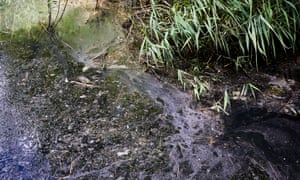Raw sewage was discharged for more than 1,000 hours from a Thames Water overflow pipe into an environmental wetland at the Olympic Park last year, the Guardian can reveal.
The combined sewer overflow (CSO) at Mulberry Court pumped untreated waste 91 times into the waterway that feeds into the River Lea. To April this year, the same CSO has so far discharged for 34 hours in 20 incidents.
The area of wetlands in east London was created as part of the development of the Olympic Park. It was hailed as a legacy project to create a haven for plants, animals and insects for the public to enjoy. Dee O’Connell, a campaigner at the London Waterkeeper charity, tweeted live footage of one of the spills.
Dee Dee May ?
(@deedeelea)? @electricadam‘s video of the raw sewage that’s being discharged right now into @noordinarypark wetlands @LDNWaterkeeper @Feargal_Sharkey @thameswater @NewhamLondon @LondonLegacy pic.twitter.com/XHdC0Q11E5
Data obtained by the Guardian and London Waterkeeper, which is campaigning for a “Thames fit to swim in”, reveals the scale of the discharges that have been permitted by the Environment Agency.
The sewage from the Mulberry Court CSO is discharged into a watercourse system in the Queen Elizabeth Olympic Park wetlands, which feed into the Lea.
Profile England’s water industry 2018-19 figures
Show
Hide

1) Anglian Water
Ownership: consortium of international investment funds
Total directors’ pay: GBP5.3m
Highest paid director: GBP1.97m, Scott Longhurst, former chief finance officer
Total dividends 2010-19: GBP5.013bn
2) Northumbrian Water
Ownership: Cheung Kong Infrastructure Holdings, a Hong Kong-based investment consortium
Total directors’ pay: GBP1.96m
Highest paid director: GBP930,000, Heidi Mottram, CEO
Total dividends 2010-19: GBP1.192bn
3) Severn Trent
Ownership: publicly listed on the London stock exchange
Total directors’ pay: GBP4.3m
Highest paid director: GBP2.4m, Liv Garfield, CEO
Total dividends 2010-19: GBP2.009bn
4) Southern Water
Ownership: privately owned, through a series of holding companies, by Greensands Holdings
Total directors’ pay: GBP2.2m
Highest paid director: GBP1.17m, Ian McAulay, CEO
Total dividends 2010-19: GBP882m
5) South West Water
Ownership: Pennon Group, a British plc publicly listed on the London Stock Exchange
Total directors’ pay: GBP2.6m
Highest paid director: GBP968,000, Chris Loughlin, group CEO
Total dividends 2010-19: GBP1.135bn
6) Thames Water
Ownership: consortium of institutional investors including funds from China and Abu Dhabi
Total directors’ pay: GBP3.5m
Highest paid director: GBP985,000, Brandon Rennet, CFO and executive director
Total dividends 2010-19: GBP1.823bn
7) United Utilities
Ownership: a British plc listed on the London Stock Exchange
Total directors’ pay: GBP6.2m
Highest paid director: GBP2.3m, Steve Mogford, CEO
Total dividends 2010-19: GBP2.553bn
8) Wessex Water
Ownership: YTL Corp, a Malaysian infrastructure group
Total directors’ pay: GBP3.6m
Highest paid director: GBP921,000, Colin Skellett, group CEO
Total dividends 2010-19: GBP1.067bn
9) Yorkshire Water
Ownership: Kelda Holdings, through a series of holding companies; 33% by Singapore government-owned sovereign wealth funds
Total directors’ pay: GBP2.9m
Highest paid director: GBP1.3m, Richard Flint, CEO
Total dividends 2010-19: GBP1.236bn
Photograph: Roger Bamber/www.alamy.com
The data reveals the CSO discharged 91 times over 1,026 hours in 2019. On 30 September, untreated sewage was released into the wetlands for 49 hours. On 8 November, 90 hours of untreated sewage discharged from the overflow pipe.
The Guardian revealed this week that more than 1.5m hours of untreated sewage was discharged into English rivers last year via CSOs. The data, obtained under environmental information requests, gives the most comprehensive picture of the scale of sewage discharges the Environment Agency allows water companies to carry out.

Theo Thomas, the founder of London Waterkeeper, said: “The Olympic Park is the biggest urban park built in a generation. It was meant to be a legacy project but 1,000 hours of sewage was spilled last year into the wetlands.
“This is a public park and what is happening is unacceptable in 2020. It shows a callous disregard for public spaces and our environment.”
Thomas is campaigning with Surfers Against Sewage for water companies to stop releasing untreated sewage into rivers.
Hugo Tagholm of Surfers Against Sewage said: “The health of our rivers is inextricably linked to the health of our ocean. Polluted rivers will always lead to a polluted ocean. We need connected and thriving aquatic ecosystems, free from sewage and pollution.”
Feargal Sharkey, the Undertones lead singer and a keen fly fisherman, said the Environment Agency was complicit in allowing the pollution of rivers through storm overflows.
“They know perfectly well what is going on. They have known about it for decades and refused to properly deal with the situation,” he said.
Profile How does England’s sewerage system work?
Show
Hide

When the sewer system is operating normally, sewage leaves homes and businesses and is treated at a treatment works. Only when it has been treated is wastewater released to the environment, either out to sea through long outfalls or coastal discharges, or into rivers.
The vast majority of England’s sewer network is a combined system, which dates back to Victorian engineering, and is designed to collect the contents of people’s toilets and surface rainwater then transfer them together to treatment plants.
After extreme rainfall, the treatment works cannot cope with the volume of water and untreated sewage. Human excrement, condoms, sanitary towels and toilet paper are released untreated into rivers through combined sewer overflow pipes – just as it was in 19th-century London.
These pipes are supposed to be a safety valve to release pressure in the system and used only when an exceptionally large amount of water enters the system.
Photograph: FLPA/Rex Features
The release of untreated sewage and waste water is permitted in extraordinary circumstances – such as extreme rainfall – to relieve pressure in the system. But critics say the Guardian’s data shows how routine sewage dumping in inland waters is.
A spokesperson for the Environment Agency said: “The sewage system is designed to overflow to relieve pressure on the system – discharges from CSOs are not a sign that the system is faulty or being misused.

“However, when companies do damage the environment, whether it is through polluting our waters or breaching permit conditions, we will take enforcement action against them including civil sanctions.”
Thames Water said: “We have invested heavily in monitoring equipment to understand how frequently spills are made to the environment, and to better target investment in the best solutions.
“Any discharge is undesirable but they only happen when there is literally no alternative and to prevent flooding to homes. It is the way the system is designed to operate.”
o Statements from the water companies can be read in full here.